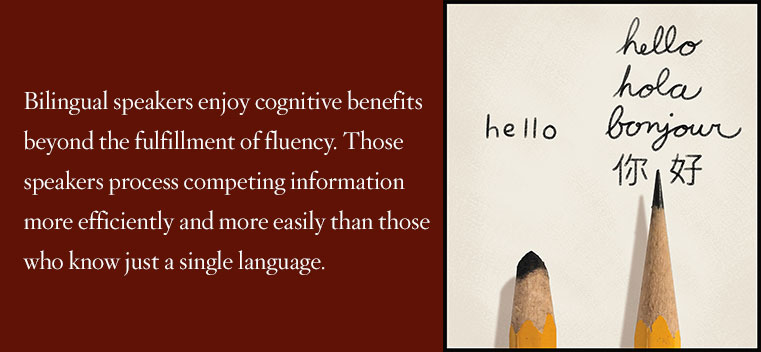
Benefits of Bilingualism
Related Articles
Want to see how you fare on a test of inhibitory control? Take a Stroop effect test.
Tell us what you think. E-mail comments or questions to the editors at letters@northwestern.edu.
Ever wonder about those strange designations we use throughout Northwestern to identify alumni of the various schools of the University? See the complete list.
Find Us on Social Media
Speaking more than one language is good for the brain.
Sprechen Sie Deutsch? Habla Español? Parlez-vous Français?
If you are one of the growing number of people who speak multiple languages, new research from Northwestern needs no translation. Bilingual speakers enjoy cognitive benefits beyond the fulfillment of fluency. Those speakers process competing information more efficiently and more easily than those who know just a single language.
The benefits occur because the bilingual brain is constantly activating both languages and choosing which language to use and which language to ignore, says Viorica Marian, professor of communication sciences and disorders in the School of Communication. When the brain is constantly exercised in this way, it becomes better at selecting relevant information and ignoring competing distractions, the researchers found.
“You constantly juggle two languages. As a result, you become a really good mental juggler,” says Marian.
She has studied co-activation, a concept she pioneered in 1999, since her days as a graduate student at Cornell University. Her earlier research showed that bilinguals never turn off their inactive language. “It’s always running in the background to some extent — it’s always co-activated,” she says. “As you hear words in either language, they get processed in both languages.”
Her latest study explores co-activation and inhibitory control in bilinguals. Inhibitory control involves selecting the correct word in the face of other competing words. In one of the first such studies to use functional magnetic resonance imaging, Marian and her colleagues measured blood flow in the brain as study participants completed a language comprehension test. The more oxygen or blood flow to the region, the harder that part of the brain is working.
Upon hearing a word, study participants were shown pictures of four objects. For example, after hearing the word “cloud,” they were shown four pictures, including a picture of a cloud and a picture of a similar-sounding word, such as a “clown.”
The bilingual speakers were better at filtering out the competing words because their brains are used to controlling two languages and inhibiting the irrelevant words, the researchers found. “The interesting thing,” Marian says, “is that the parts of the brain that are involved in language and resolving competition had to work harder in monolinguals than in bilinguals.”
Inhibitory control offers real-world advantages, Marian notes. In a study that she co-authored last year, researchers found that bilingual students are better able to filter out classroom noise than their monolingual peers.
That’s one of the many advantages of bilingualism, which appears to have benefits along the entire lifespan. Some researchers point to adaptability in babies who have been exposed to two languages from birth. In older adults, researchers report that bilingualism might delay a diagnosis of dementia. That makes sense, Marian says, because “using another language provides the brain built-in exercise.”
And, she adds, it’s never too late to learn. “You can always learn another language. And you can learn it to fluency. You can reap this inhibitory control benefit no matter what age you start.”
Marian, who grew up speaking Romanian and Russian in her native Moldova, has spent her career debunking myths about bilingualism, which she says has long suffered from an unfounded negative bias in the United States.
“People would often be told not to speak another language to their kids because it would confuse them,” says Marian, recalling advice she received from a nurse in her pediatrician’s office when her eldest daughter was a baby. (She regretfully admits that her own three daughters are Americanized monolinguals. “You know how they say that the cobbler’s kids go barefoot,” she quips.)
Today approximately 20 percent of U.S. households speak a language other than English at home. Outside of the United States, the majority of the world’s population is bilingual or multilingual.
That makes it all the more important to Marian to develop an accurate understanding of how the cognitive system functions when you know more than one language.
Want to see how you fare on a test of inhibitory control? Take a Stroop effect test.



 Facebook
Facebook Twitter
Twitter Email
Email


